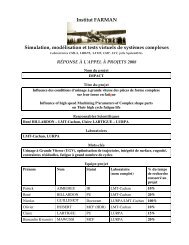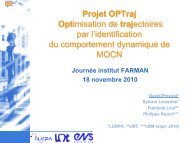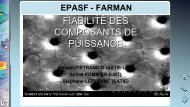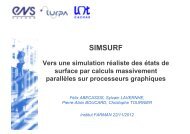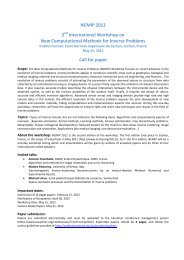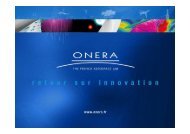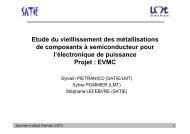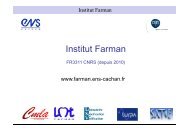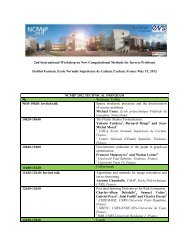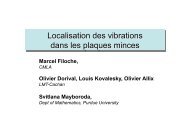DIGISCOPE 2010 Acronyme du projet - Institut Farman - ENS Cachan
DIGISCOPE 2010 Acronyme du projet - Institut Farman - ENS Cachan
DIGISCOPE 2010 Acronyme du projet - Institut Farman - ENS Cachan
You also want an ePaper? Increase the reach of your titles
YUMPU automatically turns print PDFs into web optimized ePapers that Google loves.
4. External projects;<br />
5. Dissemination.<br />
APPEL A PROJETS EQUIPEX /<br />
CALL FOR PROPOSALS<br />
<strong>2010</strong><br />
<strong>DIGISCOPE</strong><br />
SCIENTIFIC SUBMISSION FORM B<br />
The first two will take place <strong>du</strong>ring the installation of the various nodes (first three years).<br />
The last three will take place from the time a node is functional until the end of the project.<br />
Track 1: Hardware installation<br />
Due to the constraints on the availability of new buildings, but also in order to equalize the<br />
workload on the project participants and to transfer the experience gained from one node to<br />
the next, the hardware will be installed over a period of 3 years, as follows:<br />
Year 2011 Year 2012 Year 2013<br />
Telepresence infrastructure<br />
FabLab;<br />
Node at Ecole Centrale Paris<br />
Node at LTCI;<br />
Node at LIMSI (EVE extension)<br />
Node at LRI and INRIA Saclay<br />
Node at CEA LIST<br />
Node at Maison de la Simulation<br />
Node at UVSQ/OVSQ<br />
Node at <strong>Institut</strong> <strong>Farman</strong>.<br />
The staff working on the hardware installation will work as a team, rotating from site to site<br />
as needed in order to maximize exchanges and build up expertise.<br />
Track 2: Software development<br />
In parallel with the hardware installation, software development will take place over the first<br />
three years and will continue on as needed for the rest of the project. The software<br />
development team will work as a group and will be collocated at least the first year of the<br />
project. As nodes get installed it will become more efficient to distribute the team, but<br />
regular meetings, the use of teleconferencing tools and the team-building effect of the first<br />
year will ensure that the software development effort stays coherent.<br />
The <strong>DIGISCOPE</strong> software will build on existing software from the participants. It will<br />
provide a set of basic functionalities such as displaying contents from multiple sources,<br />
managing the display with windows/layers/portals, supporting distributed rendering of<br />
content for tiled walls, sharing content across nodes and managing user input in a unified<br />
way. On top of this basic layer, a higher-level toolkit will support standard interaction tasks,<br />
e.g., pointing, navigation, manipulation, visualization and sharing.<br />
The goal is to pro<strong>du</strong>ce successive releases of the <strong>DIGISCOPE</strong> software early on so that it can<br />
be quickly used for real work, and a first stable version by the end of year 2. At this point, the<br />
software will be open-sourced as much as possible to encourage dissemination and adoption<br />
by other platforms outside <strong>DIGISCOPE</strong>. Components that cannot be open sourced, such as<br />
the physical interactive simulation software components required for haptic interaction, will<br />
be made freely available to all partners and to academic institutions for research purposes.<br />
Track 3: Internal projects<br />
As the nodes get installed and the software deployed, the <strong>DIGISCOPE</strong> Program Committee<br />
will issue calls for internal collaborative projects and monitor the use of the various nodes. It<br />
will ensure that the different scientific objectives are addressed by the various projects and<br />
that the nodes are used the majority of the time for collaborative projects.<br />
16/95



